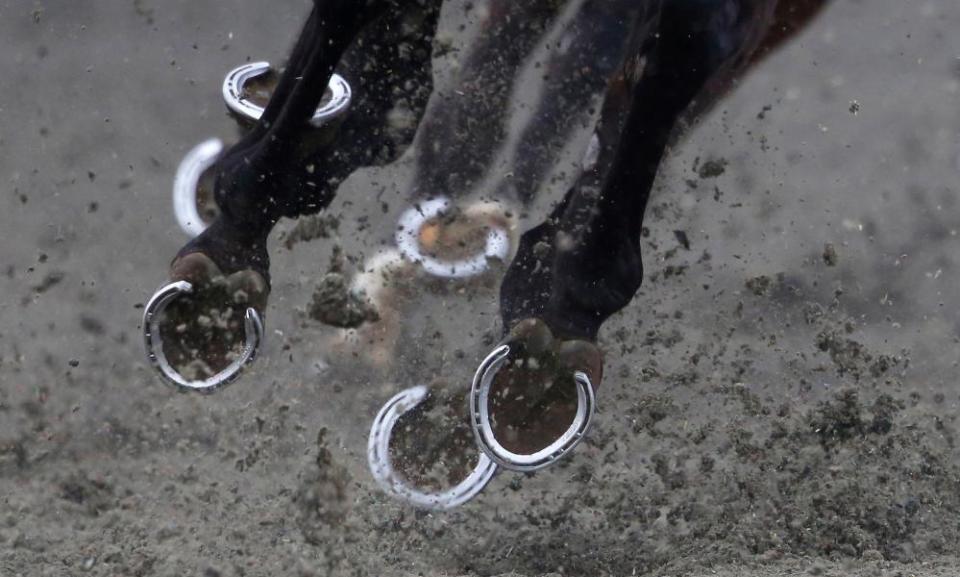How the horse became the only living animal with a single toe

They can reach speeds of more than 40km an hour, clear hurdles more than eight feet high and even pirouette – and they manage it all with just one toe on each foot. Now researchers say they have unpicked how and why horses ended up with their unusual extremities.
The only living animals with a single toe, horses once had multiple digits on their feet, with their early ancestors having four on their front feet and three on their back.
While it has long been thought that the shift was linked to horses moving from forest to grassland environments, it was unclear how this anatomical change happened.
Now researchers say they have cracked the conundrum.
“The centre digit was compensating simultaneously for increasing body size and reducing side digits – which is definitely not something we knew before,” said the aptly named Brianna McHorse, first author of the research and a PhD candidate at Harvard University.
Writing in the journal Proceedings of the Royal Society B, McHorse and colleagues reveal how they used micro-CT scanning – a type of detailed 3D x-ray imaging – to analyse the long bones of the feet from 12 extinct horses, each of a different genus, including the dog-sized prehistoric horse Hyracotherium that lived about 45-55m years ago.
For comparison, the team also looked at the bones of the South American tapir – a living species with four toes on their front feet and three on their back.
For each creature, the researchers calculated at the compressive strength of the bones and their resistance to bending, charting the changes over the family tree of horses.
They then used computer models to explore the stress placed on the bones when the horses moved, both at a trot and when jumping or rapidly accelerating. “That is going to put more stress on the bone and it reflects the times when the animals would need to quickly get away from a predator or something,” said McHorse.
For both scenarios the team modelled what would happen when the full body weight of the animal was applied only to the central toe, and then when the body weight was shared over both the central toe and any side toes.
The results reveal that when the weight of the beasts was switched from being placed solely on their central toe to also being spread over their side toes, the ability of the foot to withstand loads greater than usual increased.
That, the team note, suggests that side-toes played an important role in load-bearing over evolution.
“With more demanding locomotion … you absolutely need those side toes to bear some of the load, otherwise the stress on the central metacarpal gets close to or actually reaches the fracture stress of bone – so it would be very likely to break,” said McHorse.
But the findings also showed that this benefit decreased over evolution: by the time of Pseudhipparion, which lived between 5m and 16m years ago, the middle toe alone was almost as robust towards demanding locomotion as the combination with the side toes.
What’s more, the team found that as the animals’ body mass increased down the family tree, and the side toes shrank in size, the cross-section of the central toe became larger and its resistance to bending increased.
But it is not clear whether the changes in the central toe simply reduced the need for side toes, or whether the shrinking of the side toes drove the changes in the central toe.
The team say the findings support the idea that the increasing body mass of the animals might, at least in part, have been behind the reduction in the number of toes, with a single, very robust bone better able to withstand the greater bending forces than a foot composed of three toes which, taken together, had the same bone mass.
But McHorse says the results also add weight to the possibility that the side toes were lost to reduce the mass at the end of the leg and help them move faster and more efficiently. That, she added, could have proved particularly beneficial as the beasts adapted to grasslands and evolved longer legs, possibly to cope with covering greater distances for resources.
“It is very energetically expensive to have a bunch of toes on the end of that leg,” said McHorse. “If you get rid of them then it costs less, energetically speaking, to swing that leg for every step.”
Robin Bendrey, a zooarchaeologist from the University of Edinburgh who was not involved in the research, said the study was exciting. “[It] makes a major contribution to explaining a major evolutionary adaptative trend of the family Equidae and one which ultimately produced an animal that has been so influential in human history,” he said.

 Yahoo News
Yahoo News 